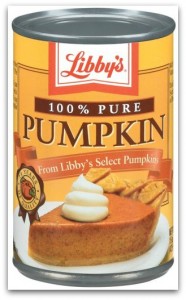Think you’ve got the answer? Keep reading to see if you nailed it.
What’s in canned pumpkin?

While we already told you the story of how the explosion of commercially-available “pumpkin spice” items don’t contain pumpkin—they’re merely made with the spices that are traditionally used to flavor pumpkin—it’s a whole different situation with canned pumpkin.
The variety of pumpkin that sits on your porch and teenagers smash and you boil yourself to make pumpkin treats is the Cucurbita pepo. Then there’s the Curcurbita moschata. It’s similar to the pumpkin, although its appearance is a faded, anemic light brown, and where a pumpkin is round, this fruit is elongated.
This plant is also known as the Dickinson squash. It was developed by food scientists at Libby’s, the food packaging company that produces 85 percent of canned pumpkin and pumpkin pie filling sold in the United States. Libby’s cans say “pumpkin,” but they’re really full of Dickinson squash, which is more closely related to butternut squash than pumpkin.
Sure, it still tastes wonderful when mixed with milk and spices and baked in a pie crust. Libby’s developed the breed to ensure consistency, and also because old-school pumpkins don’t make for very good canned pie filling. They’re 90 percent water, have hollow insides, and they cook up bland and watery.
Need more impossible questions? Check out Uncle John’s Impossible Questions.







